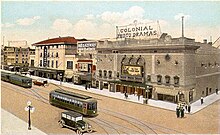Richmond Tramway, Virginia

One of the trams in the American city of Richmond (Virginia) made an important contribution to the history of the electric drive system for rail vehicles . Incidentally, the history of the Richmond trams was characterized by a large number of parallel foundings and bankruptcies and ended with a hostile takeover .
Horse rides
George L. Earnest, the founder of the first horse-drawn tram in Richmond, Virginia, started out with a bus service . On March 29, 1860 he received permission to lay rails. In the same year, the tram operation began on flat rails .
The rails were torn out during the American Civil War in 1863. It is believed that the metal was used to build the Confederate's second ironclad .
In 1866 horse-drawn trams could be resumed. Increasingly, however, trains hauled by steam locomotives also used the tracks in the streets, until this was banned by the city in 1875. More and more companies set up their lines.
Electric tram
To set up an electrical operation, the Richmond Union Passenger Railway Company was founded on March 23, 1887 . The electrical equipment was created by Frank Julian Sprague . With its single-pole overhead line and pantographs , it created the basis for the worldwide distribution of electric trams as a means of local transport . The regular service of the electric in Richmond began in January 1888. In a very short time more electric trams were set up by newly established companies in Richmond. The Richmond Passenger and Power Company , licensed on March 2, 1900 , combined the existing electric railways, but from April 13, 1900 there was a new separate company with the Richmond Traction Company .
In 1901 the last horse tram was closed due to urban pressure.
After further startups and bankruptcies, the Virginia Railway and Power Company summarized the network in Richmond on June 30, 1909 . Besides stretches in the streets, there were also stretches in the countryside and a few viaducts .
In 1945, the Virginia Transit Company bought the tram network in order to switch public transport to buses in a short time.
swell
- Richmond then and now: Earle Lutz: You've Missed the Last Trolley (newspaper article)
- Church Hill Peoples News: A history of Richmond's trolleys, with network maps
Coordinates: 37 ° 32 ′ 27 ″ N , 77 ° 26 ′ 10 ″ W.

